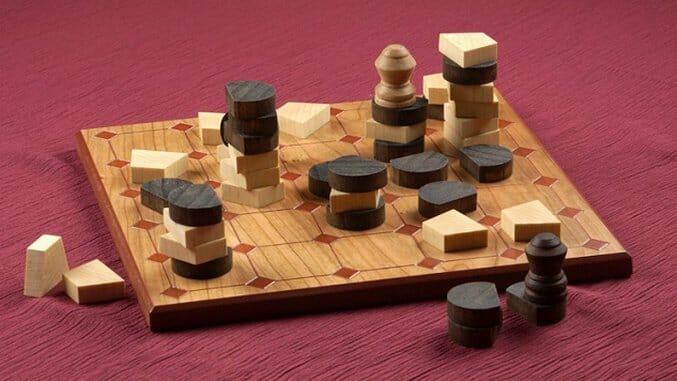Tak Brings a Fictional Boardgame Into the Real World

Tak isn’t a real game, or at least it wasn’t a real game, but now it is a real game thanks to James Ernest and Cheapass Games (and a host of Kickstarter backers). It started out as a fictional game within Patrick Rothfuss’s mammoth Kingkiller Chronicle books—over 1600 pages so far in the first two parts of the trilogy—but has now become an actual game you can play, with real rules, and a very silly constructed history too. It’s a very simple, elegant two-player game with some surprising complexity underneath, the sort of game that could keep math-minded folks occupied for many hours modeling out scenarios but requires absolutely no math skills to enjoy or win.
Disregarding the fake history, Tak is a placement game played on a 5×5 board, where the goal is to create a path between two opposite sides of the board before your opponent can do it. (A winning path doesn’t have to be in a straight line of five spaces, so long as it’s uninterrupted by an opponent’s stone or an empty space.) Each player has a set of tiles that can be played flat or standing, as well as one larger piece called a capstone. On the first turn of the game, each player places one of his opponent’s tiles flat on any space on the board. After that, players place their own tiles, and may place a tile flat or standing on any open space, or may place the capstone on any open space, or may pick up any tile or stack of tiles and move them to adjacent spaces.
Moving stacks is where the strategy lies. When you move a stack, you may move as many spaces as there are tiles in the stack, as long as you drop at least one tile from the bottom of your stack on each space you pass over. You can drop tiles on an empty space or on any flat tile (or stack of flat tiles), but can’t land on or pass over a standing tile—only a capstone, by itself, can knock over a standing tile and make it flat. Players place tiles until one completes a path across the board or all legal moves are exhausted, in which case the player covering more spaces with flat tiles wins. It couldn’t be much simpler.